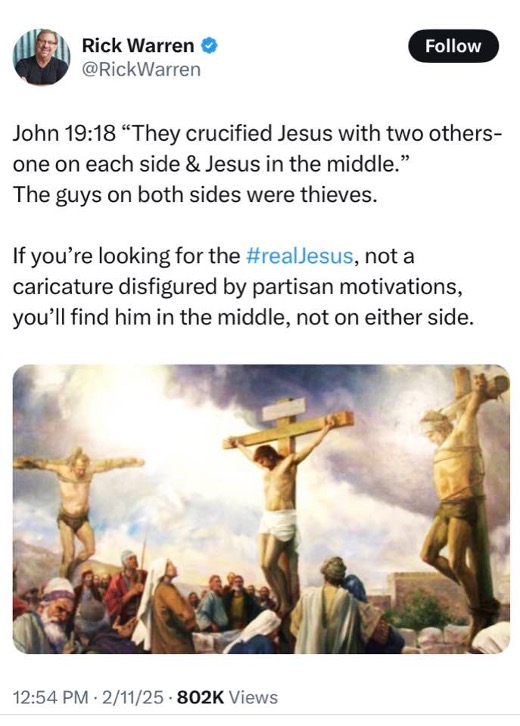Rev. Rick Warren, Evangelical best-selling author, and former mega-pastor, has stirred up controversy with a now-deleted X post that develops a rather unusual application to a biblical scene of Jesus on the cross. He contends that Jesus being crucified “in the middle” between two thieves in John 19:18 means that “If you’re looking for the real Jesus, not a caricature disfigured by partisan motivations, you’ll find him in the middle, not on either side.”

This is what I want to say to Rev. Warren:
Rick Warren, along with many, I was surprised by your interpretation and application of the biblical scene of Jesus being crucified “in the middle” between two thieves. I myself, in agreement with all past New Testament scholars, do not see any attempt by John or any of the other Gospel writers to communicate, by placing Jesus between two “thieves,” that Jesus is always in the “middle” of any partisan divide on each issue (or, as the other Gospel writers have it, between “one on his right and another on his left”).
Who are the “thieves”?
The Greek word that you rendered as “thieves” (lestai) can be translated as “robbers” or “bandits,” and is used to connote violent national revolutionaries by the 1st-century Jewish historian Josephus. Luke calls them simply “evildoers” or “wrongdoers” (Gk. kakourgoi). John uses the same word “robber” (Gk. lestes) for Barabbas (18:40), whom the other Gospel writers describe as a “rebel” or “insurrectionist” (Gk. stasiastes) who had committed murder during the “rebellion” or “insurrection” (Gk. stasis).
By your “reasoning,” the Gospel writers would be communicating that Jesus is in the middle between two different pro-banditry or pro-violent-revolution positions, which is absurd. The Gospel writers are actually trying to communicate here (as also with the Barabbas episode in Mark 15:6-14) that Jesus was mistakenly crucified as a violent zealot against the Roman occupiers of Judea.
Jesus was not occupying the middle ground.
Jesus wasn’t occupying the middle ground between competing violent revolutionary leaders. By depicting Jesus as in the middle of, or between, two violent revolutionaries, the Gospel writers are illustrating the mistake of viewing Jesus as one of them. The violent revolutionaries on either side of Jesus are not Republicans and Democrats, holders of two different political positions. The two “robbers” were being crucified for the same offense.
Jesus was not “in the middle” on a host of moral matters. He was not “in the middle” on the question of homosexual practice, incest, adultery, rape, or extortion of the poor. Nor would he be “in the middle” today on the question of chemical castration and surgical mutilation of children, “gay marriage,” forcible indoctrination of children into “LGBTQ” immorality, and abortion. Jesus was a radical on sexual ethics. Stop trying to make Jesus into your own image, or a cipher for your own “respectable” political “moderation.”
The middle is a position of drifting from Christ.
The middle between two political parties is a moving sociological target. The further extreme Left the Democrats become, the more the middle gravitates leftward. Accepting “gay marriage” within the definition of the normative meaning of “marriage” and embracing early chemical abortions have now become a staple of “the middle.” Christians can do better than being “slow Democrats” in their sexual ethics.
The Sermon on the Mount shows us a different kind of Jesus than projected by Rick Warren’s middle way. Near the start of the Sermon of the Mount (Matt 5:17-48), Jesus gives us the Six Antitheses, which can be paraphrased as: “You used to be able to get away with the following, but now I tell you, ‘No longer.’” They show a Jesus whose moral standards, if they move at all relative to his Hebrew Bible (our Old Testament), move in the direction of closing remaining loopholes and deepening God’s moral demand, not creating greater license for sin. This is a return to creation standards or God’s perfect will, not a steady drift to accommodate more and more human sin.
The warnings that close the Sermon (7:13-27) make clear that Jesus was in earnest about that message. “Few” find “the narrow gate” and hard “road that leads to life.” Those who do not “bear good” are “thrown into the fire. “Not everyone who says to me, ‘Lord, Lord,’ will enter the kingdom of heaven, but (only) the one who does the will of my Father in heaven.”
Let us find the path to life not in a sociological middle between two political parties but rather in grateful obedience to the enduring teaching of Christ, which remains as long as heaven and earth endure (5:18).
READ MORE from Robert A. J. Gagnon:
Trump’s Ban on Males in Female Sports: What It Does, Why It’s Justified, and the Left’s Outrage.
3 Major New Developments in Trump’s Battle Against Transgender Tyranny
Leftist Bishop Gets Her Bible Wrong: Falsely Attacked Trump at Inauguration Interfaith Service
Robert A. J. Gagnon is a visiting scholar at Wesley Biblical Seminary in Ridgeland, Miss., and has taught previously at Middlebury College, Pittsburgh Theological Seminary, and Houston Christian University. He has degrees from Dartmouth College (B.A.), Harvard Divinity School (M.T.S.), and Princeton Theological Seminary (Ph.D.). He has published a number of works, including The Bible and Homosexual Practice (Abingdon).




















